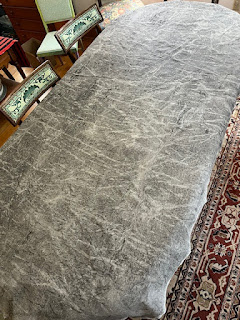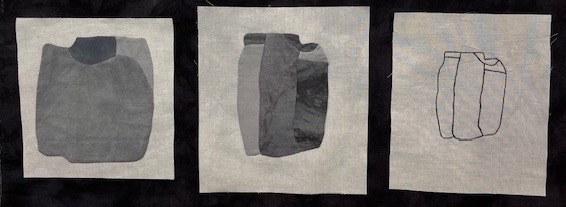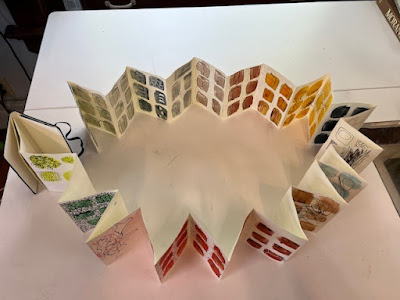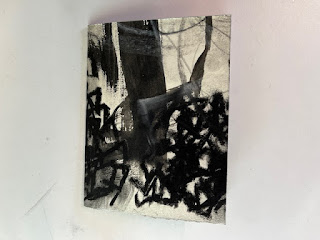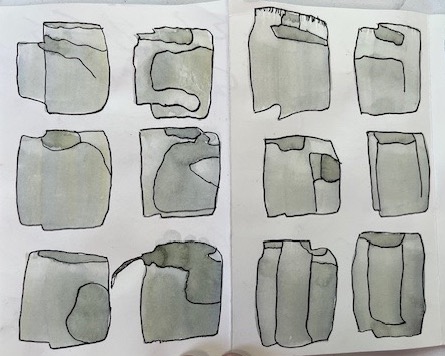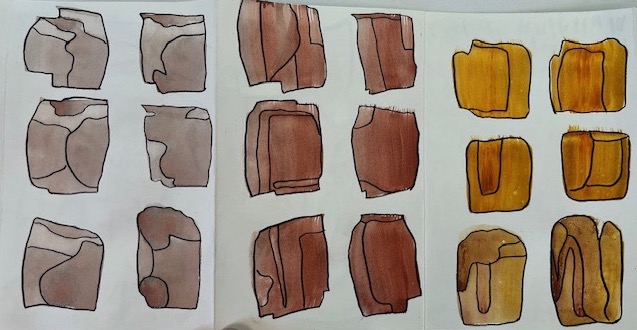December 8, 2025
Getting more studio time in my day
November 30, 2025
16 months later, continuing with "Persistence"
July 2, 2024
Coming back to "Persistence"
But as I worked yesterday morning on another version last year's sketch, I decided to abandon it, and to just go to the fabric and start stitching, letting go of any notion of re-creating the layout of the alignments. Instead of following a plan, I will let myself go wherever I find the stitches taking me. I'll also have the marks in the fabric to follow or respond to, if I wish. This is because I've decided to stitch on the "back" side of the cloth Sheryl and I colored, rather than on the solid, brownish-black side that was my original intent. Sheryl had told me that many people end up using the back instead of the front, because of the beautiful, unplanned markings that show through on the back. After doing stitch trials on both the front and the back (on the right and left in the photo below), I've decided to switch, and stitch on the back side. The stitching will not be in as high a contrast to the fabric as I envisioned, but that's OK. The variations on the back, and stitching done in response to marking, is much more in keeping with the nature of the relationship of the neolithic stones to the terrain in which they were "planted," with lines of stones following variations in the terrain.

And here's stitching done yesterday and today on the full piece of cloth, about two hours spent in total.

May 18, 2024
Following up on "Found Shapes"


 |
April 27, 2024
A Sketchbook Workshop with Susan Moss
Last week I took a three-day workshop with Susan Moss on "The Creative Sketchbook." I've long been intrigued and also intimidated by the idea of a sketchbook practice. I've tried several times to work in sketchbooks, but have never been managed to persist. I knew Susan's work through her embroidered drawings, which I find deeply moving. When I saw she was offering a sketchbook workshop, I decided to give it a try and see what might happen. I was confident that the work itself over the three days would be interesting, fun, and challenging, and if it ended there, that was OK with me. But I am taking home with me more than the sketchbook and ideas for continued practice. I also found a renewed energy to put art-making central in my daily life, an idea for a new project, and an interest in trying out some new materials. Here are some images and descriptions of what we did.
Susan provided a small Moleskin Japanese album sketchbook (accordion style, each page 3.5 x 5.5") for each participant. She also provided a huge array of paints, brushes, pencils, pens, charcoal, papers, etc. for us to work with; this was part of her encouragement to us to experiment--to try out new materials, marks, and methods. Experimentation was so much easier with the huge variety of materials that she made available to us. She also encouraged us to start out by painting color "swatches" on a number of pages in the sketchbook, using a wide brush and gouache paint. The swatches eliminate the dread of a totally clean page and the fear of what to put on it--just start by making some short brushstrokes on the page! And the swatches also give you a structure to work within/outside of, or not--it's also fine to ignore them while working over them. You can see an array of swatches across the sketchbook in this photo:
Susan provided a booklet of handouts that included prompts for drawings, prompts for reflective writing, and reflections on drawing and art in general by a variety of artists. She emphasized the importance of reflecting on what we were doing, and on our own histories of our relationship to art making. I probably spent about a third of the time writing, and two-thirds drawing.
And now some examples of the sketchbook pages. In the photo below, the four swatches on the left hand page were drawn on in response to the prompt: "Make a series of small, simple marks, filling/exploding some painted swatches." The column of three swatches on the right were done to this prompt: "Using your non-dominant hand, make some lines vertically or horizontally on painted swatches."
April 3, 2024
Two small half-square triangle quilts
 |
| "Cross the Border" pattern by Katie Pedersen, Sew Katie Did blog; my version is about 35" x 45." |
One of the pleasures of making a scrap quilt like this is looking through one's stash of fabrics, and coming across fabric from past quilts. The green check below is from the first quilt I ever made, with Katie Ortner.
February 18, 2024
Working on easy things for a while
I've recently made several lined tote bags, adapting this "Whitney Sews" pattern. I enlarged the dimensions a bit, and used quilting cotton with medium-weight fusible interfacing. (You can click on the photo below to enlarge.) Drop me a note if you'd like to know how I changed the pattern.



